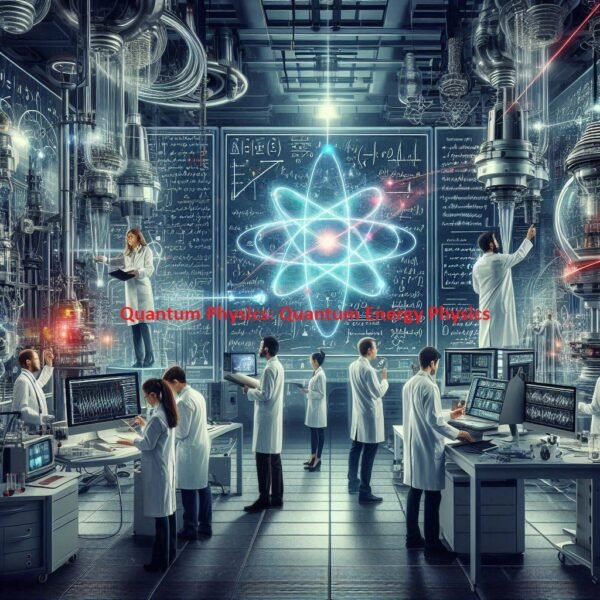Quantum Physics: Quantum Energy Physics

Overview of Quantum Physics
Quantum physics, or quantum mechanics, is a fundamental theory that describes the behavior of matter and energy at atomic and subatomic scales. It reveals phenomena that challenge classical intuitions, such as wave-particle duality, quantization of energy, and the uncertainty principle. The theory was developed in the early 20th century by physicists like Niels Bohr, Werner Heisenberg, and Erwin Schrödinger, forming the basis for modern physics and explaining various physical processes from atomic behavior to the properties of light.
MediumPulse, Medium Pulse, MediumPulse.com
Key Concepts in Quantum Physics
- Wave-Particle Duality: Quantum entities such as electrons and photons exhibit both particle-like and wave-like properties. This duality is fundamental to understanding quantum phenomena.
- Quantization: Energy levels in quantum systems are discrete rather than continuous. For instance, electrons in an atom can only occupy specific energy levels, transitioning between them by absorbing or emitting energy in quantized amounts.
- Uncertainty Principle: Formulated by Heisenberg, this principle states that certain pairs of physical properties (like position and momentum) cannot be simultaneously known with arbitrary precision. This inherent uncertainty is a hallmark of quantum systems.
- Quantum Entanglement: A phenomenon where particles become interconnected such that the state of one particle instantaneously affects the state of another, regardless of distance. This “spooky action at a distance” has implications for quantum computing and secure communication.
Quantum Energy
Quantum energy refers to the smallest discrete unit of energy that can be absorbed or emitted by an atom. The concept is crucial for understanding how atoms interact with electromagnetic radiation. The energy E of a photon can be calculated using the formula:
Applications of Quantum Energy
The principles of quantum energy have profound implications across various fields:
- Quantum Computing: Utilizes quantum bits (qubits) that exploit superposition and entanglement to perform calculations far more efficiently than classical computers.
- Quantum Cryptography: Leverages principles like entanglement to create secure communication channels that are theoretically immune to eavesdropping.
- Photovoltaics: Solar panels operate on quantum principles by converting sunlight (photons) into electricity through electron excitation.
Quantum physics fundamentally reshapes our understanding of nature at microscopic scales, providing insights into the behavior of matter and energy that defy classical interpretations. Its principles not only explain a wide range of physical phenomena but also pave the way for revolutionary technologies in computing, communication, and beyond.
Quantum Physics: A Deep Dive into the Quantum Realm
Quantum physics is a branch of physics that explores the nature of reality at the smallest scale, the realm of atoms and subatomic particles. It’s a mind-bending field that challenges our classical understanding of the world and has led to groundbreaking discoveries and technologies.
Key Concepts in Quantum Physics
-
Quantization of Energy:
- Energy is not continuous but comes in discrete packets called quanta.
- This concept was introduced by Max Planck to explain the black body radiation spectrum.
-
Wave-Particle Duality:
- Particles, like electrons and photons, can exhibit both particle-like and wave-like properties.
- This duality is fundamental to quantum mechanics and has been experimentally verified.
-
Quantum Superposition:
- A quantum system can exist in multiple states simultaneously until it is measured.
- This phenomenon is often illustrated by Schrödinger’s cat thought experiment.
-
Quantum Entanglement:
- Two particles can become entangled, meaning their quantum states become correlated, regardless of the distance between them.
- Measuring the state of one particle instantly affects the state of the other, even if they are light-years apart.
-
Quantum Tunneling:
- Particles can pass through barriers that they classically shouldn’t be able to penetrate.
- This phenomenon is essential in many technological applications, such as scanning tunneling microscopy.
Quantum Energy Physics
While there isn’t a specific field called “Quantum Energy Physics,” quantum physics has significant implications for energy research and technology. Some key areas include:
- Quantum Computing: Leveraging quantum mechanics to perform computations exponentially faster than classical computers.
- Quantum Cryptography: Developing unbreakable encryption methods based on the principles of quantum mechanics.
- Quantum Energy Technologies: Exploring the potential of quantum phenomena to harness and manipulate energy more efficiently.
The Future of Quantum Physics
Quantum physics continues to push the boundaries of our understanding of the universe. As researchers delve deeper into its mysteries, we can expect to see even more revolutionary technologies and insights emerge. From quantum computers to quantum materials, the future of quantum physics holds immense promise for shaping the world we live in.
Quantum energy physics focuses on understanding energy at the quantum level—essentially, it’s about the behavior, transfer, and properties of energy in the framework of quantum mechanics. Quantum mechanics itself is the branch of physics that deals with the smallest scales of energy levels in atoms and subatomic particles, where particles like electrons, photons, and quarks exhibit properties that defy classical expectations. Here’s a breakdown of some key aspects related to quantum energy physics:
1. Quantization of Energy
- In quantum physics, energy is not continuous but quantized. This means that particles can only possess specific, discrete energy levels. This concept was first introduced with the discovery of the quantum of action (Planck’s constant, hh) and is central to quantum mechanics.
- For example, electrons in atoms exist in quantized energy states or “orbitals.” An electron can “jump” between these levels by absorbing or emitting a photon of energy equal to the difference between the initial and final states.
2. Wave-Particle Duality
- Quantum objects, such as photons and electrons, exhibit both particle-like and wave-like properties depending on how they are observed. This duality is a fundamental aspect of quantum physics, encapsulated in the wave function, a mathematical description that encodes the probabilities of a particle’s properties like position, momentum, and energy.
3. Uncertainty Principle and Energy
- The Heisenberg Uncertainty Principle states that we cannot simultaneously know a particle’s position and momentum (or energy and time) with infinite precision. This principle introduces the concept of energy fluctuations and vacuum energy in quantum physics.
- Due to uncertainty, even “empty” space in a quantum field is never truly empty but has fleeting, random fluctuations of energy, often described as quantum vacuum fluctuations or zero-point energy.
4. Quantum Fields and Quantum Energy Levels
- Quantum field theory (QFT) extends quantum mechanics to fields, like the electromagnetic field, describing particles as excitations in these fields. Each field has its own set of quantized energy states.
- In this framework, particles like photons and electrons are seen as “quanta” of their respective fields, and interactions between particles are governed by field energy exchanges (e.g., photons are quanta of the electromagnetic field and mediate electromagnetic energy exchanges).
5. Energy in Quantum Tunneling
- Quantum tunneling is a phenomenon where a particle has a probability to “tunnel through” a barrier it classically couldn’t surpass due to energy constraints. In terms of energy physics, this is significant because it defies classical energy limitations, showing that quantum systems can exploit the probabilistic nature of energy levels.
6. Quantum Entanglement and Energy Correlations
- Quantum entanglement is a unique property where particles become interlinked in such a way that their energy states (and other properties) become correlated, regardless of the distance between them. This can lead to instantaneous energy correlations, challenging classical ideas of locality and causality in physics.
7. Applications and Technologies
- Quantum computing: Quantum computers utilize quantum bits (qubits), which operate based on quantum energy states and entanglement. The energy states in qubits can represent multiple states simultaneously (quantum superposition), allowing for highly efficient computation.
- Quantum cryptography: Quantum energy properties and entanglement are used to create secure communication channels based on the fundamental principles of quantum mechanics.
- Quantum sensing: Quantum sensors utilize quantum energy states to achieve highly sensitive measurements, often exploiting phenomena like quantum superposition or entanglement.
8. Quantum Electrodynamics (QED)
- QED is the theory that describes how light and matter interact at the quantum level. It provides a framework for understanding energy exchanges between particles like electrons and photons in terms of quantum field interactions.
9. Quantum Thermodynamics
- This field investigates how classical thermodynamic principles, such as energy conservation and entropy, apply at the quantum scale. Quantum thermodynamics explores how energy transfers in quantum systems may differ from classical expectations, often leading to unique quantum phenomena like quantum heat engines or quantum refrigerators.
Quantum Energy Physics at a Glance:
- Quantized energy levels dictate particle behavior.
- Uncertainty principles allow for non-classical energy phenomena, like zero-point energy and vacuum fluctuations.
- Wave-particle duality influences energy transfer and interactions.
- Quantum fields and particles behave as quantized field excitations, central to understanding forces and interactions.
In essence, quantum energy physics provides a foundation for understanding the fundamental processes that govern energy and matter at the smallest scales, offering insight into phenomena and technologies that shape the modern quantum era.
Quantum physics is the study of matter and energy at the atomic and subatomic level, and quantum energy is the idea that energy is transferred in discrete packets:
Quantum physics
The study of the fundamental properties and behaviors of matter and energy, and how particles interact to make up the world. Quantum physics explains natural phenomena like entanglement, superposition, and tunneling. It’s the basis for emerging technologies like quantum computing, cryptography, and sensors.
Quantum energy
The idea that energy is transferred in discrete packets, or quanta, rather than continuously. The quantum of light is the photon, and the quantum of charge is the electron.
The name “quantum physics” comes from the idea that energy comes in multiples of the same “quanta”, similar to how you can only buy shoes in multiples of half a size. The Planck constant, named after Max Planck, is the quanta in quantum physics.
